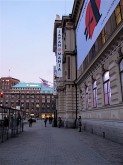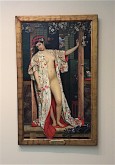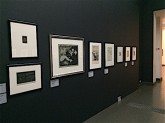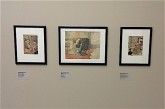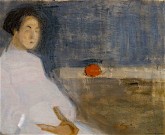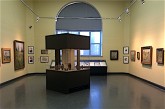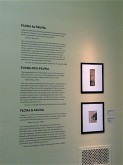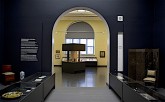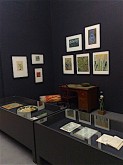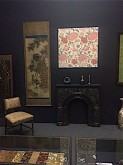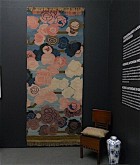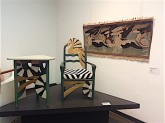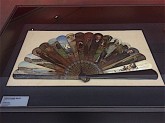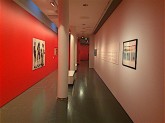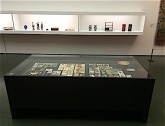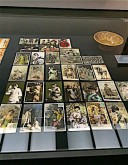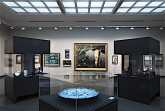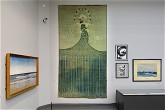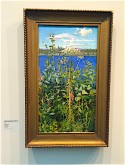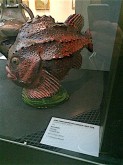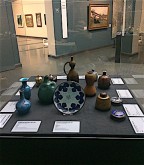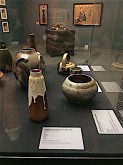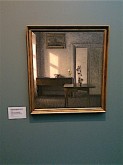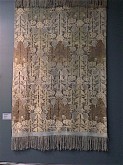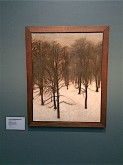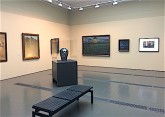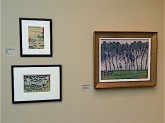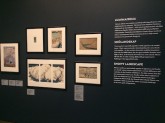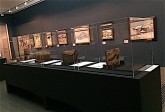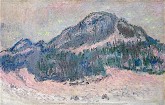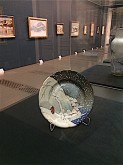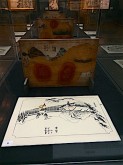The browser will either open the file, download it, or display a dialog.
Japanomania in the Nordic Countries, 1875–1918
Ateneum Art Museum, Finnish National Gallery, Helsinki
February 18–May 15, 2016
National Museum of Art, Architecture and Design, Oslo
June 17–October 16, 2016
SMK – Statens Museum for Kunst, Copenhagen
January 19–April 23, 2017
Catalogue:
Japanomania in the Nordic Countries 1875–1918.
Edited by Gabriel P. Weisberg, Anna-Maria von Bonsdorff & Hanne Selkokari.
Contributions by Gabriel P. Weisberg, Widar Halén, Leila Koivunen, Anna Kortelainen, Susanna Petterson, Malene Wagner, Ellen J. Lerberg, Anna-Maria von Bonsdorff, Nils Ohlsen, Leena Svinhufvud, Trine Nordkvelle, Vibeke Waallann Hansen, and Harri Kalha.
Brussels: Mercatorfonds, 2016.
296 pp.; 240 color and 66 b&w illus.; bibliography, list of exhibitions, index of names.
$65
ISBN 978-03-00220-11-7
Japanomania in the Nordic Countries is the first exhibition organized on this topic, shedding light on a cultural and artistic relationship, which, for most people—even scholars working on late nineteenth-century art—seemed almost unbelievable (fig. 1). Yet, faced with the great number of Nordic and Japanese works of art exhibited at the Ateneum Art Museum in Helsinki, the visitor could not but acknowledge the visual connections between these cultures. While the Japanese influence on French, English, and American art has been significantly analyzed in the past fifty years, an important amount of research still needed to be done regarding Japonisme in Finland, Norway, Sweden, and Denmark. In the five years leading up to the exhibition, chief curator Gabriel P. Weisberg (University of Minnesota, Minneapolis) in close collaboration with curators Anna-Maria von Bonsdorff (Ateneum, Helsinki) and Hanne Selkokari (Sibelius Museum/Archive, Helsinki) accomplished an extensive amount of research, bringing to the fore unknown artists and revealing the influence of Japan in the Nordic countries through a wide range of techniques.
The exhibition took place on the entire third floor of the Ateneum’s late nineteenth- century building in Helsinki. The large space devoted to the show was composed of thirteen successive rooms, which followed the division of the exhibition into the same number of themes, including “Intimate Life,” “Flora & Fauna,” “Artists’ Studio,” and “the Ideal of Simplification,” among others. The thematic approach was an effective way for visitors to grasp both theoretical and technical aspects borrowed from Japanese art by Western artists. The catalogue expands on the themes of the exhibition to further understanding of the impact of Japonisme in Northern Europe and to provide a better sense of the chronology of the various events that marked its development.
The exhibition opened with a brief introduction on Japonisme and a portrait of Finnish collector and traveller Herman Frithiof Antell (1847–93) as a symbol of this fascination with the Far East. This first room contained two large display cases in the center showing numerous objects from both Western and Northern Europe. This choice of scenography—graphic works on the sidewalls and display cases in the center of the room—was adopted in most of the larger galleries, eliciting a dialogue between the different mediums. The presence of well-known artists such as James Tissot and Alfred Stevens provided a frame of reference with which to understand the works of lesser-known Nordic artists such as Finnish painters Gunnar Berntson and Albert Edelfelt. At the end of this first gallery a number of paintings were gathered under the theme of “Elegant Exoticism,” including James Tissot’s 1867 masterpiece La Japonaise au bain suggesting an interesting interrelationship between women, eroticism, and domestic interiors (fig. 2). This facet of the Western perception of the Far East can also be seen and further analyzed through Gunnar Berndtson’s painting, Yes – No, Pause in the Studio, painted a few years later in 1879. This theme and the various questions it raises seemed to extend to the last room of the enfilade, where the visitor could see from afar another large portrait of a woman, Laurits Andersen Ring’s portrait of his wife (1897).
The following room provided the visitor with insight into the specific technique of woodblock prints. The selection of Nordic and Japanese prints offered visual evidence of the Japanese technical influence on Western art practices and provided an opportunity for the museum to show its collection of Japanese prints by Hiroshige and Hokusai, artists whose style and influence have recently been the subject of several shows and publications.[1] On the opposite side of the room, works by Alfred William Finch, Edward Munch, Eric Ehrström, and Akseli Gallen-Kallela constituted an instructive counterpoint to the influential Japanese prints (fig. 3). The dark background was especially well suited to prints, which, despite their rather wide diffusion compared to paintings and sculptures, are not often shown in museums.
The next room, devoted to “Intimate Life,” also contained several Japanese prints in dialogue with Western painters—women in intimate domestic scenes caring for themselves, accompanied by other women or depicted as mothers with their children. The way Japanese artists were representing the everyday life of geishas and courtesans could not but echo Henri de Toulouse-Lautrec’s or Edgar Degas’s fascination with women’s intimate life or the more decadent facets of life in Paris in the late nineteenth century (fig. 4). While the visitor may have had some difficulty understanding the relationship between the Japanese and Western artworks, this room showed some of the most striking comparisons in the whole show, including Helene Schjerfbeck’s Costume Picture or The Baker’s Daughter (1913) and prints by Utamaro (fig. 5). Beyond the evident formal relationship, Schjerfbeck’s painting also demonstrated that the influence of Japanese art on women artists could lead to a rather different approach to “Intimate Life”—more serene, more focused on quiet introspection. Although men were predominant in the turn-of-the-century artistic scene, the exhibition managed to include a few other women artists in the following rooms.
The next theme “Flora & Fauna” juxtaposed a wide range of objects and materials that are rarely seen displayed together (figs. 6, 7): Japanese and japanesque objects in a display case in the center of the room, a selection of katagami successfully shown on a backlit board, a door curtain by Frida Hansen; paintings by Western artists showing landscapes, flowers, and birds; and Japanese prints punctuating the whole set.[2] Except for the larger formats, most of the works shown in this room seemed a bit lost, an impression that was accentuated by the high ceilings and pale yellow background of the walls. While the visitor might have expected information on the specific relationship between Nordic artists and nature through their knowledge of Japanese art, the room offered only quotes by English and French artists, Lewis F. Day and Vincent van Gogh (fig. 8). How did the observation and study of Japanese art by Nordic artists redefine the way they represented the nature surrounding them? And to what extent was this influence different from van Gogh or Gauguin’s work? The answers to these questions can be found, in part, in the catalogue (246–53).
The corridor-like transitional space that followed was devoted to the role played by Japanese art in Western decorative arts (fig. 9). In addition to the numerous objects displayed in most of the rooms throughout the exhibition, this section offered a further examination of the production of objects, from their sources (pattern books) to fabrication (fig. 10). Unlike the other rooms, which effectively mixed French, English, and Nordic artists, here “International Japonisme” and “Nordic Japonisme” were respectively presented on the right and left hand sides of the room, ostensibly to emphasize both similarities and differences. Like Christopher Dresser, William Morris, or Emile Gallé, Nordic artists seemed to have a new ornamental vocabulary and a means with which to extend their practices to tapestries, ceramics, and enamel work in the arts of Japan (fig. 11). But Nordic Japonisme was closely related to the artists’ increasing interest in national myths and their “intense love of nature” (142–63). While this aspect was well intentioned through a careful selection of works, including a charger by Andreas Schneider and a carpet by Frida Hansen, most of the other works on display regrettably were missing their labels (fig. 12).
Despite the title “Artists’ Studio,” the following section provided an interesting illustration of the previous theme, giving further evidence of the close relation between national identity, Japonisme, and the search for innovative designs (fig. 13). Displaying Gerhard Munthe’s unique furniture designed for the Fairy Tale Room in the Holmenkollen Tourist Hotel (Christiana) and several additional tapestries by Frida Hansen, this section showed that Japanese art affected not only artists’ techniques and motifs, but also their everyday visual environments (fig. 14) (196–205). As Carl Larsson’s Portrait of the Architect Jacob Ahrenberg (1898) illustrates, Nordic artists not only were surrounding themselves with Japanese objects, they were also using them as a means to signal their modernity or their openness to extra-European cultures more broadly (fig. 15). The painted wooden hand fan owned and painted by Thorolf Holmboe, which, once opened, reveals all the feathers of a peacock, also demonstrates how deep and pervasive the Japanese influence was on Nordic artists (fig. 16). In addition, this room included major publications of the time such as Louis Gonse’s L’art japonais (1883), demonstrating that Japonisme involved not only formal aesthetic relationships, but also a broader intellectual interest in the art and culture of Japan.
How did Nordic artists become aware of Japanese art? Exhibitions and universal expositions, as shown in the following space, were the main venues at which artists could see and examine the works of ancient and contemporary Japanese artists (fig. 17). These events were held not only in Western Europe and America, but also in Nordic countries. The chronology displayed along the wall provided a significant overview of exhibitions from 1873 to 1918, which allowed visitors to understand the increasing frequency of Japanese art shows organized by both museums and private associations. The visitor might have expected more visual materials related to these exhibitions, such as ephemera and posters.
“Japanomania Hits the Street” was undoubtedly the least expected section of this exhibition, yet the most revealing in terms of social context (figs. 18, 19). Exhibited in two display cases in the center of the room, about a hundred postcards showed the extent to which Japonisme affected popular culture and mass media—1.7 million postcards were mailed in Finland in 1900. From Tissot’s painting shown in the first room to the postcards showing mostly Western women dressed in kimonos, one could further analyze the close relationship between Japonisme, exoticism, and the eroticization of the female body. Overall, this section gave a sense of both the vertical and horizontal diffusion of Japonisme, expanding from the aristocracy to lower classes, from the fine arts to its appropriation by popular culture (256–61; 262–69). The porcelain and lacquerware displayed in the back of the room conveyed the same idea.
Although the following theme “Nature from Near and Far” overlapped a previous section in several ways, it also provided additional insights into Nordic artists’ new conceptions of landscapes (fig. 20). Their observation of Japanese art appeared, indeed, as a vantage point to understand some of the main evolutions that marked the art of Nordic landscape painters at the end of the nineteenth century. These evolutions were less concerned with the themes adopted by the artists than new formats and compositions. Hung on the back wall, Jarl Eklund’s carpet entitled Seagull (1904) was the most remarkable case study of this section (fig. 21). Depicting a crown-like series of flying seagulls at the top of a stylized gigantic wave, the work appears almost like a homage to Hokusai’s wave, displayed next to it. A katagami also featuring a wave demonstrated the popularity of the motif in Japan, which then inspired the Norwegian painter Nikolai Astrup (1880–1928). The artists’ observation of ukiyo-e prints and paintings led to a redefinition of their format and composition as seen in several Nordic paintings including Akseli Gallen-Kallela’s Wild Angelica (1889), chosen for the cover of the exhibition catalogue (fig. 22). In this section, a close-up of a specific artist such as Jens Ferdinand Willumsen would have been useful in demonstrating how Japanese art affected the work of an artist as both a sculptor and a painter and, in general, to create links between the objects on display in the center of the room and the paintings on the walls (fig. 23).
Leaving this room, the visitor entered a smaller space devoted to “The Ideal of Simplification.” While the theme is relevant and fundamental regarding the arts of Japan, further explanations as to where exactly this concept came from and how it impacted Western art, specifically Nordic artists, would have been helpful to the visitor (164–71). The room, however, offered a rare occasion to admire a selection of Vilhelm Hammershoi’s paintings along with artistic stoneware vases by Alfred William Finch as well as copperware by Eric O. W. Ehrström (figs. 24, 25). But without any comparative Japanese prints and paintings, without any references to Hammershoi’s readings or his personal collection, it was difficult to decipher any Japanese influence in his empty interiors; at first glance, the compositions seem more indebted to the seventeenth-century Dutch painter Johannes Vermeer (fig. 26). In dialogue with Frida Hansen’s door curtain, his trees were more convincing, recalling, for example, the work of the Japanese painter Yamamoto Baiitsu (figs. 27, 28).
Trees provided an effective visual transition to the following room whose theme was “In the Sacred Woods.” Although the section’s title seemed to reiterate the two rooms already devoted to the realm of nature, the woods appeared to be a relevant theme at the crossroads of Japanese art, symbolism, and Nordic mythology (fig. 29). Unlike the previous room, an almost systematic comparison with Japanese prints enabled the visitors to acknowledge significant visual correspondences between, for example, Alfred William Finch’s Rainy Weather at Hampton Court and Hiroshige’s landscapes (fig. 30). The paintings’ tall and narrow compositions, seen in the previous rooms, were used to depict mythological themes, serving almost as an excuse to represent stylized skeletal trees as in Hugo Simber’s On the River of Life (1896) (fig. 31).
Entering the last room the visitor was surrounded by snow: this impression was all the more vivid as the whiteness present in all the exhibited works contrasted very effectively with the dark wooden floor and the dark blue walls (figs. 32, 33). The “Snowy Landscapes” of Sweden, Finland and Norway, as painted by Pekka Halonen and Askeli Gallen-Kallela, among others, echoed the famous views of the Mount Fuji by Hokusai, for example, and Utagawa Kuniyoshi’s prints depicting snow. The room also contained several of the landscapes painted by Claude Monet in Norway, providing a compelling case study with which to question our perception of exoticism. Aware of their distinctiveness, Nordic artists often showed winter scenes in Parisian exhibitions, where they were often perceived by other artists as exotic. On a visit to his stepson in Norway, Monet explored the region around Oslo and eventually stayed for six weeks near the town of Sandvika where he painted several views of the Mount Kolsås, which bears a clear resemblance to Mount Fuji (fig. 34). The artist’s observation of Japanese prints, which he collected, played a role in his perception of the snow, shaping his approach and the composition of his paintings in Norway (28–30). The large room also featured a number of objects including both French and English ceramics, a tapestry by Anna and Gustaf Fjaestad, and a series of woodblocks prints after Hiroshige showing the process of printmaking by the contemporary Japanese master printer Keizo Sato (figs. 35, 36, 37).
Showcasing more than 400 works of art and exhibits, Japanomania in the Nordic Countries held at the Ateneum managed to visually convince its visitors of the formal, technical, and cultural interactions between Nordic countries and Japan at the turn of the twentieth century. The thematic approach enabled the exhibition to cover the main issues at stake in this phenomenon, and the catalogue further elaborates each of its themes. This exhibition also offered a rare opportunity to discover a number of lesser-known artists whose works were almost systematically confronted with those of celebrated painters. Although one may regret the absence of Nordic photography, the emphasis on the objects and popular materials effectively revealed the cultural and visual impact of Japonisme in Northern Europe, beyond the strict artistic phenomenon (215–21). With another selection of art works and a different scenography at the two succeeding venues in Oslo and Copenhagen, the exhibition will certainly shed light on other fascinating aspects.
Etienne Tornier
PhD candidate (Université Paris Ouest Nanterre La Défense and University of Minnesota)
Researcher, INHA (Institut National d’Histoire de l’Art), Paris
etienne.tornier[at]gmail.com
I would like to thank Professor Gabriel P. Weisberg, Anna Maria von Bonsdorf, and Susanna Pettersson, who contributed in making a rich and thrilling series of events for the opening week of the show. I am also very grateful to Lorri Todd for her help.
[1] Among the most recent shows are Hiroshige, l’art du voyage, Pinacothèque de Paris, Paris, October 2, 2012–March 17, 2013 and HOKUSAI, Grand Palais, Paris, October 1, 2014–January 18, 2015.
[2] During the conference day held at the Ateneum in relation to the opening of the exhibition (February 19, 2016), Akiko Mabuchi, director of the National Museum of Western Art in Tokyo, gave a talk on “Katagami and European Design,” which shed light on the role played by these stencils meant for dyeing textiles that were extensively collected by private collectors and Western museums in the late nineteenth century.


